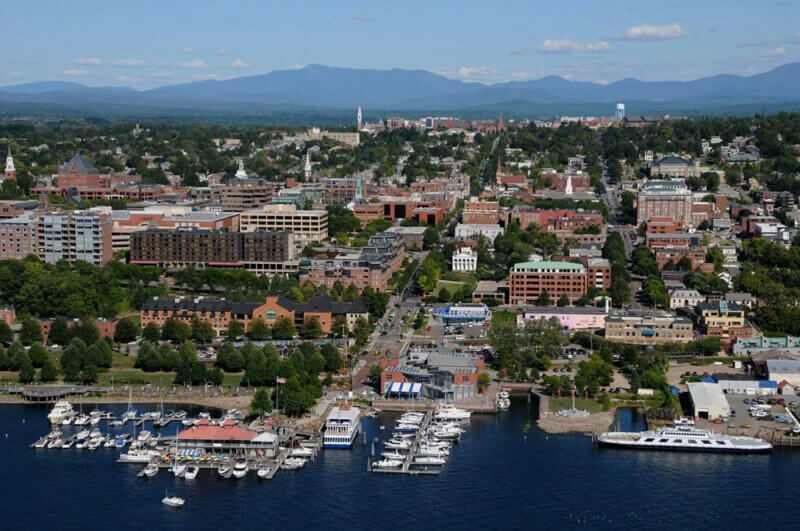Lakeside businesses eye water quality impact from floods
Vermonters saw firsthand how intense rainfall within those fateful 48 hours in July broke records, homes, farms and lives. At the bottom of it all sat Lake Champlain, a trough for the floodwater barreling down its shores.
Over the course of a seven-day period around the floods this summer, hundreds of metric tons of phosphorus poured into Lake Champlain, explained Matthew Vaughan, chief scientist at the Lake Champlain Basin Program.
“We had something like 60-70 percent of the annual (phosphorus) TMDL allocation go down in one week,” Vaughan said, using a term for the regulated total maximum load of nutrients that can enter the lake daily.
Too many nutrients essentially equals a delicious feast for bacteria in the water. The combination of readily available food and calm, sunny periods conjures up ideal conditions for cyanobacteria blooms, which can produce toxins harmful to humans and pets. The same conditions beachgoers love help produce cyanobacteria that often close the beaches along Lake Champlain.

Lake Champlain and the Burlington waterfront.
The effect of cyanobacteria on water quality concerns local businesses, too, and the seeming increase in extreme rainfall has those lake-reliant groups planning for the future.
“We rely on that water for training, and if those beaches are closed because of the quality of the water, that really impacts us,” said Robert Wilczynski, co-owner and instructor trainer at the Waterfront Diving Center in Burlington. “We have to go a great distance to get any kind of water that allows us to go in and do the training safely.”
The increased trend in alarming weather events is so noticeable that Wilczynski said he’s considering training people in confined water, like pools, rather than in the lake, even though pools in the area “are very scarce.”
The need to rent facilities means increased costs, conflicting with the center’s aim to keep services affordable for customers.
The Lake Champlain Community Sailing Center, right off the lakeside bike path in Burlington, has faced a similar set of concerns.
Cyanobacteria blooms disrupt boat launching, and “in the event that the blooms are more pervasive, we’ve run our programs from keelboats only,” said Owen Milne, executive director of the center, referring to boats designed to stay stable and keep folks out of the water.
Milne said the July flood and cyanobacteria blooms alone did not necessarily have a drastic impact on the center’s operations; he estimates around 12 days this year required adjustments because of water quality concerns.
The killer, he said, was the rain itself.
This summer was dominated by rainy days, so intuitively people stayed home instead of heading out for a day of sailing. What did this mean for Milne’s center? “Our earned revenue from sailboat rental services was about 50 percent lower than in previous years,” he said.
Still, both the Waterfront Diving Center and the Community Sailing Center are looking to the future with an optimistic eye keenly aware of continued weather impacts. That is to say: they believe in their adaptability and resilience.
“We are the last, I believe, scuba shop in the state,” Wilczynski said. “Some groups have been diving together for many, many years.”
“It’s a community that we’ve fostered, and I don’t really see that community going away,” he said.
Wilczynski acknowledged the center will need to evolve to meet the challenges of climate change. Pivoting to indoor water training when conditions necessitate will be one of such adaptations.
The Community Sailing Center recently took a step that its leaders hope will improve their operations in the face of environmental challenges like cyanobacteria blooms.
Late last month, the center broke ground on a more robust waterfront facility. The update will place docks farther out into the water, Milne explained. “Doing so will enable us to have greater flexibility for (launching) boats on those days when there are cyanobacteria blooms closer to shore.”
While he doesn’t welcome climate change and its impacts, Milne tries to stay optimistic about it all. At least, he reckoned, it could mean extended recreation seasons ahead.
Businesses are not the only entities with an eye toward resilience.
Mae Kate Campbell, an associate scientist with the Lake Champlain Basin Program, explained how “a lot of the work that we do focuses on reducing further phosphorus inputs into the lake.”
The program, a congressionally-designated initiative to conserve Lake Champlain and its neighboring ecosystem, funds projects that help capture stormwater runoff, ultimately lessening the amount of excess nutrients in the lake.
Campbell said researchers are wrapping up a program-funded study exploring the emerging topic of how to address legacy phosphorus. That’s phosphorus already present in the lake, either suspended in the water column or bound up in sediment.
The study investigated four techniques in Missisquoi Bay, each with the potential to reduce phosphorus: dredging, circulation, oxygenation and phosphorus inactivation.
“So that’s exciting research to see, and something we’ll definitely be releasing some more information on in the coming months,” said Campbell.
(The Community News Service is a program in which University of Vermont students work with professional editors to provide content for local news outlets at no cost.)

